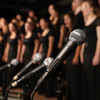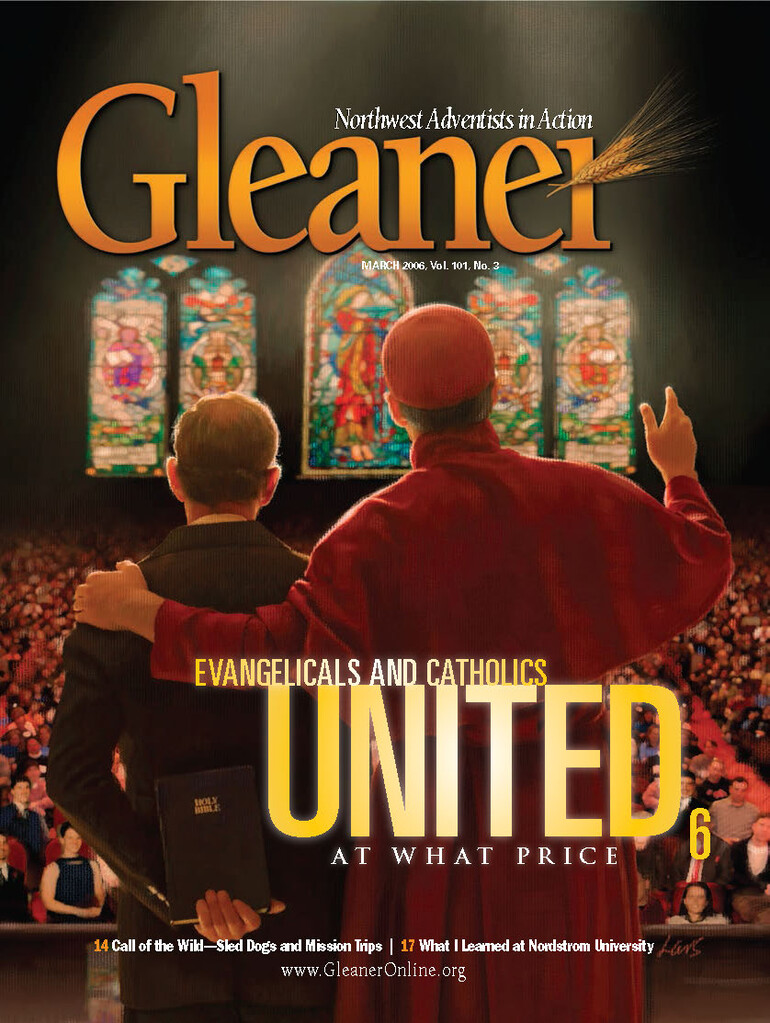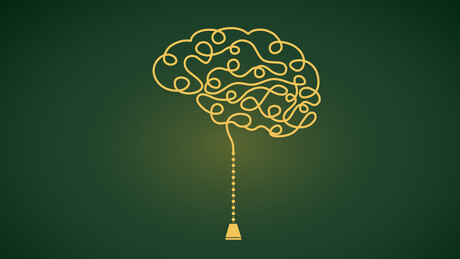Some people have taken their anti-Catholic activities to an extreme extent. This article is not intended as an attack on Catholics or conservative Evangelicals. (The official statement about how Adventists view Catholicism.) The intent of this article is to alert Northwest Adventists to the unfolding events and movements that are taking place, which were foretold in Bible prophecy and the writings of Ellen G. White. — Editor
On the morning of April 7, 2005, I will never forget sitting on the edge of my bed in a Washington, D.C., hotel room, with my eyes transfixed on the front page of The New York Times. Pictured were President George W. Bush and First Lady Laura Bush kneeling, along with former presidents Bill Clinton and George H.W. Bush, in prayerful reverence beside the deceased body of Pope John Paul II as he lay on display in St. Peter’s Basilica in Rome.
Even at a funeral wake, it was as if the leader of the free world had abdicated the throne to a deceased monarch—to Christ’s so-called vicar or chosen representative on earth and to a system that James Madison once described as “the worst of governments … [because] in the Papal system, government and religion are in a manner consolidated.” As Howard Chua-Eoan, news director and senior editorialist for TIME magazine reminds us: “The pope is one of the world’s last absolute rulers and answers only to God.”
Towering behind them and looking on with reverential awe, were numerous Catholic cardinals, nuns and Vatican officials. They, perhaps more than most, were mindful of this specific moment in history, when for the first time a U.S. president, representing the uncontested superpower of the world, attended the funeral wake of a pope. This powerful symbolic moment highlighted how far U.S.-Vatican relations had progressed since Vatican II and since President Ronald Reagan’s appointment of a permanent U.S. ambassador to the Vatican in 1984.
If there was ever a moment—rich with prophetic imagery—in which the “deadly wound” of Revelation 13 was significantly healed and in which “all the world wondered after the beast,” it was this event. More than 160 heads of state and diplomatic representatives, representing more than 90 countries, attended John Paul’s wake—and millions more stretched out for miles waiting in line to pay their last respects. Who can doubt the restoration of Rome’s enormous power and influence in the world? As William Johnsson, Adventist Review editor, summarized it: “Not in the entire history of the papacy has it commanded such universal attention.”
The memory of this event has largely been forgotten by the public, but the prophetic implications remain fresh in my mind.
Since these events, I have considered Adventist interpretation of prophecy and asked: If our Protestant, republican country—founded on the principle of religious freedom—is going to form an “image” to the “beast,” how will this happen? In my search, I discovered a definitive prophetic model: “In order for the United States to form an image of the beast [in the likeness of Rome], the religious power must so control the civil government that the authority of the state will also be employed by the church to accomplish her own ends” (Ellen G. White, The Great Controversy, p. 443).
In the current unfolding drama, we see evangelical Protestantism and Catholicism in the U.S., along with the Vatican, uniting to dramatically shift the balance of power between church and state in America. Driven by a thirst for political power, unmatched since the days of the Holy Roman Empire, and inherently joined at the hip with the most powerful nation in the history of the world (more powerful than the Rome of the Caesars), this revolutionary realignment, this apparent national revival, this powerful “image” of Rome, will appear to be blessed by Christ himself.
Revelation chapter 13 first describes a beast interpreted by many Protestant scholars as papal Rome. During 1,260 years this beast persecuted millions of Protestants and Muslims, enslaved civilizations, and controlled emperors, kings, and the armies of Europe for its own spiritual and political kingdom purposes.
Verses 11–15 describe the development of a second beast power that appears like a lamb and yet speaks as a dragon. This second beast leads the world in a religious and political revival or awakening, represented in verse 13 as “fire” coming “down from heaven,” as if blessed by God himself. This religio-political revival with its great signs and miracles has been identified with spiritualism (and/or the charismatic movement) because we are told that it ends up “deceiving the inhabitants of the earth” (verse 14).
Nearly 120 years ago, Ellen G. White declared: “When Protestantism shall stretch her hand across the gulf to grasp the hand of the Roman power, when she shall reach over the abyss to clasp hands with spiritualism, our country shall repudiate every principle of its constitution as a Protestant and republican government and shall make provision for the propagation of papal falsehoods and delusions” (Testimonies, Vol. 5, p. 451). In the scenario depicted, the stage has been set and the line of no return has been crossed.
First, the unprecedented diplomatic alliance that the U.S. government has forged with Rome since the advent of Pope John Paul II is plain for all to see. Second, newly crowned Cardinal Joseph Ratzinger as Pope Benedict XVI, formerly the Vatican’s doctrinal enforcer of the faith, is offering Europe and the United States some lessons on what he believes the proper roles of church and state should be. Finally, combine this with the rapidly growing alliance between Evangelicals and Catholics in America, and the way it is changing the balance of power between church and state in ways once only imagined, and we can see how our country is on the road to repudiating its constitutional principles.
In January’s issue of First Things, an American Catholic journal, Pope Benedict XVI recently examined the moral decline of Western society and offered a subtle, yet radical, change in the modern relationship between church and state. In the essay titled “Europe and Its Discontents,” Benedict applauds the model of the Holy Roman Empire. Throughout the essay, based on his stated belief from the book of Daniel that God raised up the Holy Roman Empire on the ruins of the Roman Empire, he does not seem to believe that it ever dominated the state.
This comes at a time when President George W. Bush, shortly after the announcement of Pope Benedict XVI’s election, had already declared in a speech before the annual National Catholic Prayer Breakfast in Washington, D.C., that “Catholics and non-Catholics alike can take heart in the man who sits on the chair of St. Peter, because he speaks with affection about the American model of liberty rooted in moral conviction.”
Benedict proposes that Pope Gelasius I’s (492-496 AD) model of church and state is the ideal model for the United States to adopt: “On worldly matters, priests should follow the laws of the emperor installed by divine decree, while on divine matters the emperor should submit to the priest.” The model he proposes is not in harmony with the American experiment. Nor does he intend it to be. While matter-of-factly observing that the American experiment in separating church and state has fostered the church’s ability to thrive, the church is not playing as effective a role as it could be.
Benedict asserts that the “dictatorship of relativism” has been the foundation of all secular governments throughout history—particularly in Western Europe and the United States—and is the cause of the precipitous decline of values and thus of the role of the church in Western society. Citing the French Revolution as the historical birth of the secular state, he argues that the result was the abandonment and exclusion of “any divine guarantee or legitimation of the political element... declaring that God is a private question that does not belong to the public sphere or to the democratic formation of the public will.” In his first encyclical, released in January, he argued that even though it is not the role of the church to “replace the State, … the church is duty-bound to offer, through the purification of reason and through ethical formation, her own specific contribution towards understanding the requirements of justice and achieving them politically.”
In effect, Benedict argues that the transition to the secular state has caused all the corrupting ills of modern society, and that the solution is for the church to rebuild itself—without threatening to dominate the state (or so he assures)—so that it helps to reshape the governments of the world, including the United States, into governments that officially recognize the healing power of the church. The “dictatorship of relativism,” he argues, is what has restrained secular governments from having a meaningful and united relationship with the church in a way that heals the world. It is, he concludes, the only way to restore God’s society or kingdom on earth.
Benedict’s proposed solution to remake society by shifting the balance of powers between church and state is troublesome. If Benedict truly believes that America’s model of liberty is adaptable to Pope Gelasius’ model of church and state, one has to define what he means for the emperor to administrate God’s “divine decree.” If he is equating “decree” with the Decalogue, then how are the roles of church and state applied? If it is the role of the emperor to administer both tables, then Benedict clearly does not respect our American tradition. But then again, why should he? Neither do many Evangelicals in America who see no problem with the state involving itself in both.
Paul Elie, in an exclusive article in The Atlantic entitled “The Year of Two Popes,” concludes that Pope Benedict will not be a significant pope because he does not truly understand or appreciate the American experiment in democracy. Mr. Elie misses the point. Could it be that just as the new pope has never seen a need to compromise with Protestants on doctrinal matters—citing as he has in the past the doctrine of papal supremacy—that he, like Evangelicals in America intent on rewriting America’s constitutional history and turning the constitutional clock backwards, see it as the church’s responsibility to influence, even compel, through democratic means, the state to constitutionally sanction and enforce acts of worship and devotion (particularly in public schools), acts that we understand are clearly outside of the proper realm of the state? What would follow? A Sunday worship law? Certainly you get the picture.
William Johnsson states an ever present reality: “Seventh-day Adventists are still Protestants. We protest, as Martin Luther and the other reformers protested, because the more Rome changes, the more Rome stays the same.” And yet Evangelicals and Catholics are uniting as never before.
When one combines the thinking of Pope Benedict XVI with Evangelicals who are rabidly promoting the constitutionalization of prayer (i.e., an act of worship) in public schools, one has to legitimately wonder where this movement is leading—no matter how well-meaning. Is our nation, and the world, beginning to experience the dawn of a spiritual awakening, or are subtle social, cultural and spiritual forces gradually shaping the political and constitutional direction of our country—forces that demonstrate that Bible prophecy is right on target, right on time?
In a public forum held in Key West, Florida, in May 2005, sponsored by The Pew Forum on Religion and Public Life, Rick Warren, author of The New York Times #1 bestseller, The Purpose Driven Life, and TIME magazine’s most influential Evangelical in America in 2005, pointed to a significant trend taking place in America. He said there are distinct “signs of a possible spiritual awakening in America” reminiscent of, but exceedingly more consequential than, America’s first two Great Awakenings, characterized by an “evolving alliance between evangelical Protestants and Catholics, particularly in the evangelical wing of Catholicism.” Three things in 2004 indicated the power of this developing ecumenical spirit: 1) the blockbuster success of the movie The Passion produced and directed by Mel Gibson, 2) the runaway success of his book, The Purpose Driven Life, and 3) the “values voters” who swung this past presidential election. He observed, “In all three of those, Catholics and Evangelicals came down on the same side of the fence. Now when you get 25 percent of America, which is basically Catholic, and yet get 28 to 29 percent of America, which is evangelical, together, that’s called a majority. And it is a very powerful bloc, if they happen to stay together on particular issues.”
This reflects a growing harmony, and consequently a growing hegemony, of evangelical Protestants and Catholics involving social, cultural and political matters. An alliance of this magnitude is, by nature, transformational, becoming a very influential and politically powerful “lobby.” But it also indicates that doctrinal agreement—whatever supposedly exists—is being largely shaped by a shared effort to defeat nihilistic behaviors of depravity that are regularly advanced in the name of protected civil rights. Thus, what is depicted as a national spiritual revival is in fact political in nature and scope.
This can be seen in several other important ways.
• Para-church Organizations
Pastor Rick Warren observed that many types of para-church organizations were proliferating across the country and contributing to this sense of “awakening.” Largely independent of denominational financial sustenance, most of these organizations are charitable and clinical social-welfare programs. But many others have sprung up over a concern with moral values and have organized with a specific political mission in mind.
A primary example of this is a para-church organization known as The Catholic Alliance or Catholic Citizenship. Formed under the aegis of the Christian Coalition, it works in league with the U.S. Conference of Catholic Bishops, whose stated motto is: “In the Catholic tradition, responsible citizenship is a virtue; participation in the political process is a moral obligation.” It was the primary influence in getting out the Catholic vote for George W. Bush during the presidential campaigns of 2000 and 2004.
• Political Ecumenism
Employing the ecumenical mandate of Vatican II, leading Evangelicals and Catholics signed the groundbreaking document “Evangelicals and Catholics Together” (ECT) in 1994. The achievement of doctrinal unity by building on the foundation of shared cultural, moral and political values was the intent. As Wheaton College professor Mark Noll notes in his recent book, Is the Reformation Over?, ECT was a reflective response to appeals from the two principle founders of the Catholic Alliance, Keith Fournier and Pat Robertson. Keith Fournier, who is executive director of the American Center for Law and Justice (otherwise known as ACLJ and founded by Pat Robertson), wrote: “We Christians, regardless of our different confessions and traditions, desperately need to become allies to push back the darkness with the light of the Evangel and the empowerment of His Spirit.”
• Immigration Trends
Evangelicals, especially politicians, are being forced to recognize the growth of the Catholic Church in America as a result of the rapid flow of illegal immigrants from Mexico and Latin America. Once many of these immigrants are naturalized, the eventual number of congressional seats will only increase the number of Catholics in office. As a result, the Catholic vote is likely to become more critical in communities all across the nation.
• Electoral Trends
Few realize that close to 30 percent of all members of Congress are Catholic, making up the largest single denominational representation. While Protestants dwarf that number—representing approximately 50 percent—the most significant factor is that a conservative contingency of evangelical Protestants and Catholics unmistakably controls Congress.
• Supreme Court Appointments
Equally significant is the unified effort to control the courts, particularly the U.S. Supreme Court. According to John Green of Pew Forum, this represents the ultimate prize and a source for much of why evangelical Protestants and Catholics have found unanimity on core cultural and political issues. They “believe that permissive judges are the root of much evil in America, and consequently they have allowed President Bush enormous latitude as long as they thought he would deliver on judicial nominees.” He has delivered, and the consequences could be devastating for religious freedom in America, particularly in the realm of Establishment Clause jurisprudence.
For the first time in our country’s history, the U.S. Supreme Court has a Catholic majority—Chief Justice John Roberts and Justices Samuel Alito, Clarence Thomas, Anthony Kennedy, and Antonin Scalia. With this composition, it is not surprising that the editors of The Economist magazine recently dubbed the new court “The Papal Court,” because that is indeed where we seem to be heading—a papal tradition of misapplying the first table of the law of God.
• School Prayer
One of the alarming things about the “Papal Court” is that all of the Catholics except Justice Kennedy are disposed to rule in favor of government sponsorship of prayer in school under the guise of preserving the original intent of the nation’s founders, otherwise known as “strict construction.” Prior to the Senate confirmation hearings, Judge Alito freely shared with Senator John Cornyn (R-Texas), a member of the Senate Judiciary Committee, that he believed that the Supreme Court had erred in its church-state separation decisions, particularly school prayer. And yet voluntary student-led prayers are already allowed under the Constitution. This signals to any rational observer that more is at stake: the allowance of government to officially sanction, and even enforce, acts of worship in the public sphere.
• The Ten Commandment Model for Church and State
This matter is of supreme importance to Adventists because it involves a fundamental misapplication of the proper roles of church and state. Acts of worship and devotion are proprietary and sacred between God and man. Unless there is a sufficiently compelling governmental interest to deny any specific act of worship—such as conduct that is blatantly harmful to one’s neighbor or the community as a whole—in the realm of worship, no state possesses the jurisdiction, even when invited and encouraged by the church or para-church lobbies, to impose how, when, or where one should pray or who to pray to. Government sponsorship of prayer in public schools runs afoul of this principle.
However, the state has a divine obligation to regulate man’s relationship with man. Christians, and all others, have a societal duty to demand that government leaders maintain a high standard of public morality as depicted in the last six commandments, which involve familial and spousal honors and duties, as well as criminal behavior. Regulating man’s relationship with man is a necessity in any society seeking order and peace instead of disorder and chaos. In this sense, Seventh-day Adventists should be champions of traditional moral values.
• Judge Roy Moore
Dubbed the “Ten Commandments Judge” for defying an Alabama Supreme Court order handed down by his peers to remove a 5,280-pound monument of the Ten Commandments from the Alabama Supreme Court building, Judge Roy Moore argues in his autobiography, So Help Me God, that “The Supreme Court of the United States and lower federal courts of this land have demonstrated their disdain for the fundamental morality upon which our country was established by creating ‘rights’ granted by man and not by God.”
In response, the question naturally follows: Whose rights, whose laws? Who is in charge of interpreting the law? If God, as Judge Moore claims, then the church or individual with the claim to a direct connection with God reigns supreme—potentially despising, discriminating, and persecuting all others refusing to align themselves with their religious pronouncements and enforcements in the public square.
• Abolishing the Constitution
This very spirit is alive and well in leading Catholic circles. Richard Neuhaus, co-author with Charles Colson of the seminal document “Evangelicals and Catholics Together,” once dabbled with the idea of abolishing the U.S. Constitution in a series of articles written by some of the signers of this document in his journal, First Things, back in 1996. The arguments were drawn from Francis Schaeffer’s classic book, A Christian Manifesto, that if America’s depraved tilt continued to spiral downward, at some point Evangelicals and Catholics, as “co-belligerents,” would need to overthrow their government in order to achieve its righteous demands.
Richard Neuhaus is the same author who in The Catholic Moment declared, “This can and should be the moment in which the Roman Catholic Church in the United States assumes its rightful role in the culture-forming task of constructing a religiously informed public philosophy for the American experiment in ordered liberty.”
“The Roman Church is … employing every device to extend her influence and increase her power in preparation for a fierce and determined conflict to regain control of the world, to reestablish persecution, and to undo all that Protestantism has done. Catholicism is gaining ground on every side.… These things should awaken the anxiety of all who prize the pure principles of the gospel” (The Great Controversy, p. 565).
We see the growing power and influence of Rome joining with evangelical Christians and the political might of the United States as never before. The predicted three-fold union appears poised to stage the last conflict on earth. The swelling multitudes are calling for transformational change—in political and judicial arenas, as well as in houses of worship. But who are they worshiping? What spirit is directing it? Their call for “Christian unity” is an appeal to strength in human might and voting power, cast as duty to God. Voices are clamoring even now for us to repudiate the principles of our constitution and to sacrifice doctrinal differences on the altar of moral and political reform.
As Seventh-day Adventists at this crucial time, we must bow, not to political or papal powers, but in renewed consecration to the Creator of the universe. He, too, is calling us to transformation: to a renewed study of His Word and a revival of primitive godliness among us. His kingdom is not of this world. We must fix our eyes on Jesus, the true vicar or representative of God, coming soon to end the Great Controversy.










